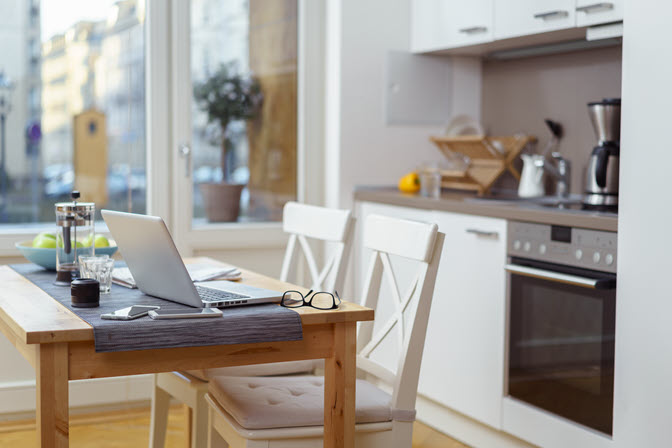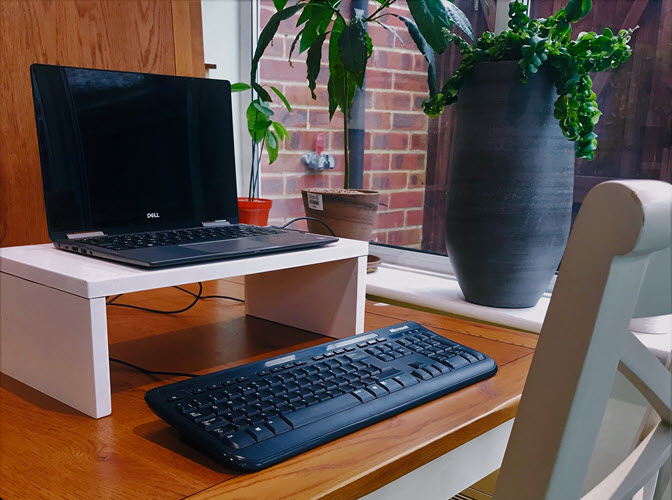Working from home
This information is intended to help those employees who are new to home working and need to know the essential elements of working safely and efficiently at home in the short, medium or long-term.
Your company should have already briefed you about much of the below, but let’s bring it all together in one place just in case.
What Will I Need?
Work may have already provided you with the equipment, IT setup and guidelines for working from home, but here’s the essential elements of what you’ll need:
- A laptop or computer
- Stable and reliable internet access
- Secure remote access to the corporate network/intranet
- Access to corporate emails
- A work phone (if company policy)
For many companies, accessing the corporate email, intranet and file storage could be as simple as securely logging into one or more websites or cloud applications. Other organisations may require that you use a VPN (virtual private network) to connect to these systems - or indeed to the internet as a whole - to ensure that your connection is private and secure from attack. This is because IT cannot be sure that your home network is secure, or that you won’t decide to work using a public wifi connection. If you need to use a VPN, your IT team should have instructed you how to set this up.
Setting Up Your Home Workspace
The first thing you will need to do is decide the place in your home that you will be working. There are several things to consider which are covered in the next sections.
Designate a suitable space to work
As much as you might want to wake up and work directly from the comfort of your own bed, in the long term it’s not going to aid in your productivity.

This doesn’t mean you need to go and create an exact office space in your house with office furniture, office chairs, office desks and desk chairs, but just have an area that can be used solely for working purposes so you can differentiate when you are in the ‘Working zone’.
One important aspect is ensuring that your setup is safe for you to work at for longish periods. We’ll discuss breaks shortly, but the main priority is to ensure that the place where you’ll be spending many hours working on your computer each day is fundamentally safe from an ergonomic standpoint.
Now let’s look at some top tips for a safe working setup.
Don’t work on a surface that’s too low or too high
You should not be hunched over when typing - so a coffee table is out for working for any length of time. Similarly you shouldn’t be typing under your chin so forget a breakfast bar with a standard chair.
A kitchen or dining table is slightly higher than a working desk, so you may want to add a cushion to your seat. If you do, it’s really important that your feet are still on the floor so as not to put pressure on the backs of your knees. You can avoid this by putting something like a thin box or thick book on the floor.
Top tip: Many people use a standing desk to avoid sitting all day whilst working. Recreate this at home by taking an ironing board and setting it at a comfortable height to type whilst standing up. To avoid wobble and a possible laptop catastrophe, put it against a wall to make it more stable. This should not be your permanent workstation, but for variety it’s an excellent option.
Don’t have a permanent twist in your neck or body
It’s really important not to work with a constant twist in your neck. If you often need to refer to a print document or a second screen that is over to one side, you may want to ask work for a document stand that you can easily clamp to the edge of your desk or table to hold the item behind your laptop screen or, if you have a computer with a monitor, position the two centrally side-by-side.
Change it up
Constant, regular changes to your working position are a good thing. If you want to work standing at your kitchen worksurface for a time then go for it. If you want to spend the morning on the sofa with the laptop on your knee then go ahead (although this shouldn’t be your permanent workspace – it’s not great for your arms and nowhere near as comfortable as you might at first think).
Consider a laptop-raiser
If a laptop is your permanent computer when you’re at work, then you should be using a laptop-raiser (a stand that brings the screen of the laptop up to the right height – with the top of it somewhere near your eye-level) and a separate keyboard. Of course, this does not apply if you use a laptop in clamshell mode (permanently closed) with a separate keyboard and monitor.

If you haven’t got access to a laptop raiser then a box or stack of books will do as well. However, if it looks like you’ll be working from home for long periods, you may want to ask work for a laptop raiser plus separate keyboard to recreate this optimal working position.
Lighting
Getting lighting right can make a huge difference to how you feel while you're working. It's important to try to find a place where you have natural light. Try to position your screen so you aren't getting reflections or glare on it. Don't sit facing towards a window because you will probably have to strain to see your screen against the bright light from the window. Blinds can help to soften the light and prevent reflections. If you need to, change the angle of your screen to reduce or eliminate any reflections.
It's also important to work on a surface that is not creating glare. Sometimes using a tablecoth or similar will help to eliminate glare and reduce you fatigue levels through the day.
Dealing with distractions
If there are children or other people around in your home, try as much as possible to keep this as a separate, private working space for you. It's important to help them understand that this is your working area - and try to clearly signal when you're working and when you're available.
If you have children under a certain age at home, you'll obviously need to discuss this with work and make a suitable, flexible arrangement that safely balances work and childcare (more on working hours below).
Take Regular Breaks
It’s important to take breaks from your work to maintain productivity and prevent injury. How many times do you sit down to get work done and find yourself “working” and yet getting little completed?
That’s not necessarily a tip specific to remote workers, but at home you don’t have the cues for lunch breaks or time away from your desk that rejuvenate you ready for the next challenge, so you need to schedule that time in. Taking regular breaks will help you remain focused and remove any kinks that are building up due to, what might be, a less than perfect ergonomic working setup.
Set Yourself Working Hours
One of the hardest aspects of working remotely is concentrating on the task at hand. There are many distractions that do not exist at work and it’s easy to become distracted by what’s happening on Facebook, the TV (that you decided to turn on briefly in a coffee break), visitors popping over or even the mound of laundry that needs doing. This can mean you find yourself working sporadically throughout the days, evenings or even weekends.
One benefit of working from home is that you can break off if something important does actually arise, but keeping regular hours as if you were at work is key. So set yourself some rigid working hours where you shut everything off and try to remain focused on the task at hand. Ask family and friends not to call you during those hours and put off those household errands as if you were actually at work.
By the way, those rigid hours don’t need to be 9-5 so long as this is ok with your employer.
You know better than anyone when you do your best thinking and working so take advantage of it. Most employers won't mind what hours you keep so long as you are getting the work completed on time and to a quality standard - as well as still attending all calls and online meetings, of course.
That's the beauty of being flexible; you should be able to work the hours that suit you when you know you are most productive.
Remaining Focused and Positive
During this period of working from home, our mental health is something we need to prioritise as much as our physical health. We've mentioned taking breaks to help keep well and focused. It's important to use those breaks to concentrate on positive activities and avoid things that may increase our levels of stress or anxiety.
Get physical
Use breaks to do some physical exercise if you can. Short amounts of physical activity of any kind is a really good counterbalance to even long periods of sitting. If you have stairs, then walking up and down them for five minutes will get your heart pumping. Do some squats or starjumps or, if you have a smartspeaker, ask for a workout and it will offer you several; from a short, high intensity workout to a yoga or pilates session. You could also do some quick household chores - they're good exercise and you'll feel virtuous for getting the housework done.
If you have a dog or a garden then it is useful to get some fresh air. Activity combined with the added bonus of fresh air is an excellent tonic to stress and anxiety. If you have neither, then open a window while you work.
Avoid too much media
During this period, it will be vital for our mental health to avoid the constant checking and monitoring of news and especially social media. Keeping strict limits on when we check these will help us remain more positive, keep a good work-life balance and be more focused and productive.
Just as we shouldn't be checking work emails on evenings and weekends, avoid checking social and other media throughout the day. Put your phone out of arm's reach (preferably in another room) and keep your attention on work and not the wider world outside and all it's worries. Whatever you do, do not have constant, rolling news on in the background on the TV or radio.
Instead of putting on the news, select some suitably calming music that will help with a positive working atmosphere. It can increase focus and reduce feelings of isolation. You can even ask your smartspeaker for background cafe or office sounds.
If it helps, there are apps you can use on your laptop/workphone to limit or block distractions (such as news and Social Media apps/websites) so you can really focus on work – although IT may need to give permissions for such apps to be installed.
Use Voice and Video as Well as Text
When you are working remotely, what you are required to do can be lost in text translation and things may not be as clear as if you were discussing a project in person.
It is beneficial if you can supplement email or text communication with frequent online 'face-to-face' and voice interactions depending on what type of discussion you are having.

Video conferencing and talking on the phone helps convey tone of voice and body language that are fundamental to communication being effective and are better to use for more serious, in depth work challenges.
Audio/video calls with colleagues are not only great for collaborative working, but they can be good company for isolated team members. Some teams actually leave a group online meeting going throughout the day so that it feels like the usual office team environment.
Top tip: Be careful, though, to be properly dressed for a video call. Many an employee has been caught out when, on joining an online meeting, the video from their laptop camera was on by default and it caught them in their pyjamas. Many home workers still choose to dress for work. You may want to consider this as it can help you 'get into the work zone' - as well as avoiding any chance of a pyjama faux pas.
Dealing With Sensitive Information
There are also some things to consider relating to the General Data Protection Regulation (GDPR) whilst working from home. It's important to be aware of sensitive information and how best to keep it away from eyes that shouldn't see it - and this does include spouses, family and friends. So, when you're away from your computer, always try to lock the screen (Windows key+L on a PC, CMD+CTRL+Q on the Mac) and keep all sensitive paperwork or printouts tidied/stored away and not scattered around in plain view.
Don't bring any sensitive paperwork home with you unless you absolutely have to. as again this can be a breach of GDPR. If you have to, make sure you've assessed the risks and tried to minimise them).
So first decide if you really need to take any paperwork home and, if you do, consider tips such as only taking the necessary part of a larger document or make a copy (if the original document isn't required). Or even better an electronic scan stored on your phone or laptop). When travelling home, keep all documents out of sight in a firmly closed bag or locked briefcase and never leave them on-view in your car.
Lastly, just as you’re advised to shred your own sensitive documents (like bank statements etc) before putting them in the bin or out for recycling, it’s important that you do the same for any work-related documents.
Having Problems with Home Working?
If you’re feeling uncomfortable, having difficulties staying focused or experiencing any other issues associate with working from home, it’s really important to let work know. It might be that you’re struggling with some aspects of your role without having colleagues at hand, or an issue with the physical or technical setup of your equipment.
One way to let work know (and explore more helpful tips) is to update your ClearTalents profile. This will help you ensure that your workspace is set up correctly, as well as guiding work to discuss and effectively address the issues you’re experiencing.
More Information
Here is an excellent guide to home working, published by ACAS (the Advisory, Conciliation and Arbitration Service):
